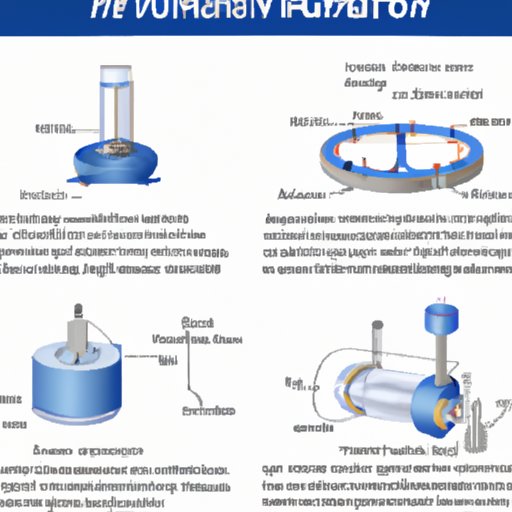Introduction
A vacuum pump is a device used to create a vacuum. A vacuum is a space in which the pressure is lower than atmospheric pressure. Vacuum pumps are used in many different industries, from medical and scientific research to industrial manufacturing. In this article, we will explore the basics of a vacuum pump and how it works. We will also discuss the various components of a vacuum pump and the different types of vacuum pumps and their applications.
Explaining the Basics of a Vacuum Pump: How Does it Work?
A vacuum pump is composed of several key components that work together to create a vacuum. The first component is the motor, which is responsible for powering the pump. The second component is the impeller, which is a rotating part that creates a low-pressure area inside the pump. The third component is the diffuser, which helps to channel the air as it is being sucked into the pump. Finally, the fourth component is the exhaust valve, which releases the air after it has been compressed by the pump.
The process by which a vacuum pump creates a vacuum involves the motor powering the impeller, which rotates at high speed. This rotation causes a low-pressure area inside the pump, which draws in air from the outside environment. The air is then channeled through the diffuser and compressed by the pump. Finally, the compressed air is released through the exhaust valve, creating a vacuum inside the pump.

An Overview of the Components of a Vacuum Pump and their Functions
The four main components of a vacuum pump are the motor, the impeller, the diffuser, and the exhaust valve. The motor is responsible for powering the pump, while the impeller is a rotating part that creates a low-pressure area inside the pump. The diffuser helps to channel the air as it is being sucked into the pump, and the exhaust valve releases the air after it has been compressed by the pump.
In addition to these four components, there are other parts of the pump that help to regulate the flow of air and maintain the vacuum. These parts include the intake port, the check valves, and the pressure regulator. The intake port is responsible for allowing air to enter the pump, while the check valves prevent air from escaping the pump. The pressure regulator is responsible for maintaining a constant pressure within the pump.

Understanding the Different Types of Vacuum Pumps and their Applications
There are several different types of vacuum pumps, each with its own unique set of applications. The most common types of vacuum pumps include rotary vane pumps, piston pumps, diaphragm pumps, and turbo pumps. Rotary vane pumps are commonly used in medical and scientific research, while piston pumps are often used in industrial manufacturing processes. Diaphragm pumps are ideal for applications that require a steady, consistent flow of air, while turbo pumps are used in high-vacuum environments.
A Step-by-Step Guide to Setting up and Using a Vacuum Pump
When setting up and using a vacuum pump, it is important to take certain safety precautions. First, make sure that the power source is properly grounded and that the electrical connections are secure. Next, attach the appropriate fittings to the intake and exhaust ports. Finally, turn on the pump and adjust the pressure regulator if necessary.
Once the pump is running, it is important to monitor the pressure gauge regularly to ensure that the vacuum is maintained. If the pressure drops too low, it may be necessary to adjust the pressure regulator or replace the filter. Additionally, it is important to periodically check the check valves to make sure that they are functioning properly.
Analyzing the Benefits and Drawbacks of Using a Vacuum Pump
Using a vacuum pump can provide a number of advantages for a variety of applications. Vacuum pumps are able to create a higher level of vacuum than can be achieved through other methods, such as fan-based systems. Additionally, vacuum pumps are relatively quiet, energy efficient, and easy to maintain.
However, there are some potential drawbacks to using a vacuum pump. For example, vacuum pumps can be expensive to purchase and maintain. Additionally, they can require a great deal of space and can be difficult to install in tight spaces. Furthermore, vacuum pumps can be susceptible to contamination if not properly sealed.
Conclusion
In conclusion, a vacuum pump is a device used to create a vacuum. The process by which a vacuum pump creates a vacuum involves the motor powering the impeller, which rotates at high speed and creates a low-pressure area inside the pump. There are several different types of vacuum pumps, each with its own unique set of applications. Using a vacuum pump can provide a number of advantages for a variety of applications, but there are also some potential drawbacks to consider.


